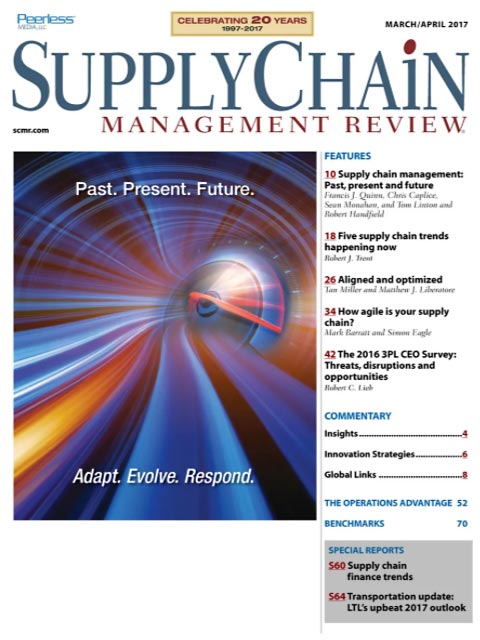Sorry, but your login has failed. Please recheck your login information and resubmit. If your subscription has expired, renew here.
March-April 2017
Supply Chain Management Review, which is celebrating its 20th anniversary with this issue.Twenty years after the premier issue, our goal remains the same: To present thought leadership around best practices in supply chain fundamentals, publish case study examples of what leading companies are doing in their supply chains and keep our finger on the pulse of emerging trends and technologies that will shape the future. While Frank’s essay looks to the past and brings us to the present, we also have essays from four experienced supply chain professionals looking to the future of supply chain management. Browse this issue archive.Need Help? Contact customer service 847-559-7581 More options
While recently talking to a senior supply chain executive from a U.S.-based CPG manufacturer, the conversation turned to Zara’s customer responsive, agile supply chain—a strategy that is based on the use of local suppliers, large amounts of spare distribution center capacity and strategically placed time-based buffers. The manufacturer’s response was one of shock: “Fifty percent spare capacity is just a huge big waste, and therefore a cost that we cannot even come close to justifying.” This reaction—and misconception— is typical of most if not all manufacturers. It is especially true for those that are the most heavily invested in Lean manufacturing and have spent years driving waste and cost out of manufacturing operations and supply chains. Yet local sup¬ply and spare capacity are precisely what allows Zara to identify and respond to new trends by designing, manufacturing and delivering new fashions to its stores in a fraction of the time of traditional retailers.
Why do these misconceptions of agility exist and how can they be overcome? How can CPG manufacturers and retailers develop an agile capability that will significantly improve their supply chain performance? To answer these questions, let’s begin by looking briefly at what exactly supply chain agility means.
What is supply chain agility?
In essence, agility is the ability of a supply chain to autono¬mously respond to demand—and its variations—with buffers that are minimized, albeit of the right size, and in the form that best serves both the company and its customers. Finally, those buffers are part of the supply chain design.

This complete article is available to subscribers only.
Log in now for full access or start your PLUS+ subscription for instant access.
SC
MR
Sorry, but your login has failed. Please recheck your login information and resubmit. If your subscription has expired, renew here.
March-April 2017
Supply Chain Management Review, which is celebrating its 20th anniversary with this issue.Twenty years after the premier issue, our goal remains the same: To present thought leadership around best practices in supply… Browse this issue archive. Access your online digital edition. Download a PDF file of the March-April 2017 issue.While recently talking to a senior supply chain executive from a U.S.-based CPG manufacturer, the conversation turned to Zara's customer responsive, agile supply chain—a strategy that is based on the use of local suppliers, large amounts of spare distribution center capacity and strategically placed time-based buffers. The manufacturer's response was one of shock: “Fifty percent spare capacity is just a huge big waste, and therefore a cost that we cannot even come close to justifying.” This reaction—and misconception— is typical of most if not all manufacturers. It is especially true for those that are the most heavily invested in Lean manufacturing and have spent years driving waste and cost out of manufacturing operations and supply chains. Yet local supply and spare capacity are precisely what allows Zara to identify and respond to new trends by designing, manufacturing and delivering new fashions to its stores in a fraction of the time of traditional retailers.
Why do these misconceptions of agility exist and how can they be overcome? How can CPG manufacturers and retailers develop an agile capability that will significantly improve their supply chain performance? To answer these questions, let's begin by looking briefly at what exactly supply chain agility means.
What is supply chain agility?
In essence, agility is the ability of a supply chain to autonomously respond to demand—and its variations—with buffers that are minimized, albeit of the right size, and in the form that best serves both the company and its customers. Finally, those buffers are part of the supply chain design.
SC
MR


Latest Supply Chain News
- Technology’s role in mending supply chain fragility after recent disruptions
- Tech investments bring revenue increases, survey finds
- Survey reveals strategies for addressing supply chain, logistics labor shortages
- Israel, Ukraine aid package to increase pressure on aerospace and defense supply chains
- How CPG brands can deliver on supplier diversity promises
- More News
Latest Podcast

 Explore
Explore
Topics
Latest Supply Chain News
- Technology’s role in mending supply chain fragility after recent disruptions
- Tech investments bring revenue increases, survey finds
- Survey reveals strategies for addressing supply chain, logistics labor shortages
- Israel, Ukraine aid package to increase pressure on aerospace and defense supply chains
- How CPG brands can deliver on supplier diversity promises
- How S&OP provides the answer to in-demand products
- More latest news
Latest Resources

Subscribe

Supply Chain Management Review delivers the best industry content.

Editors’ Picks





